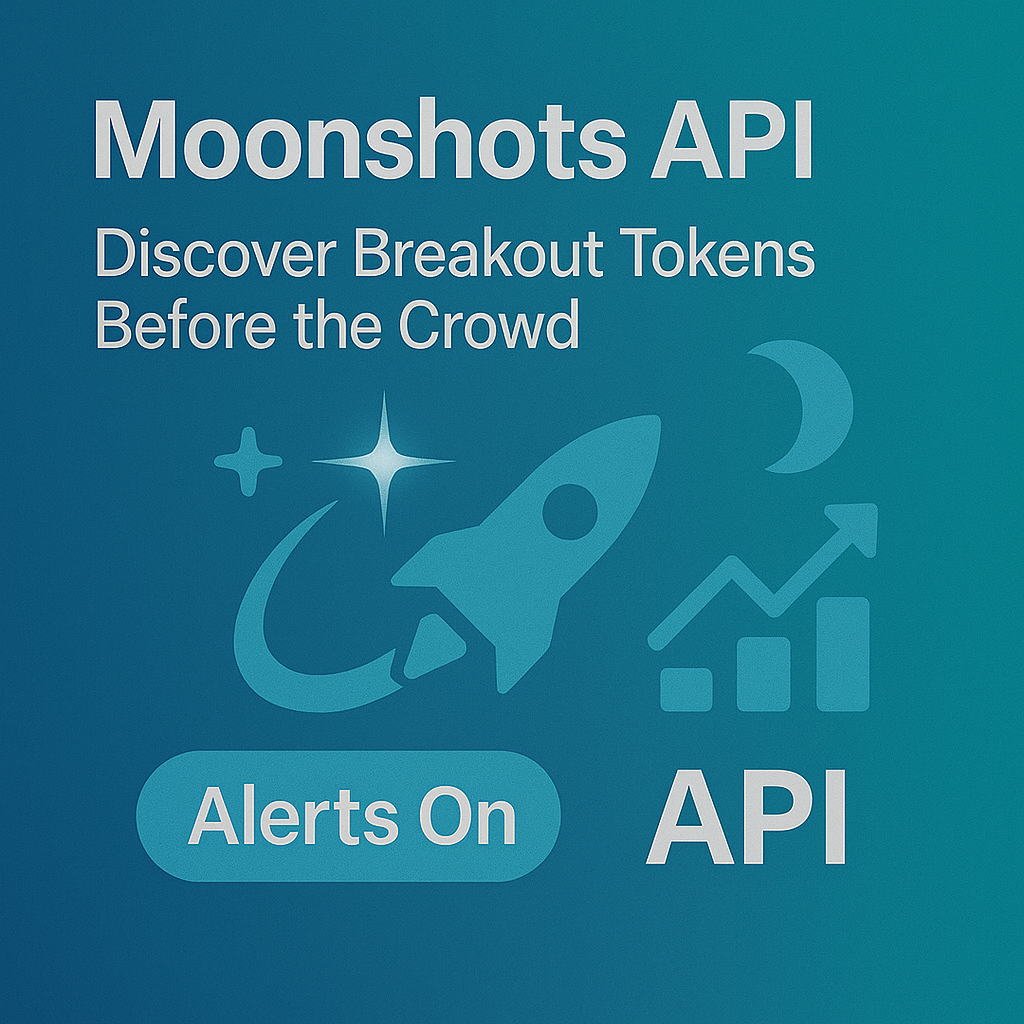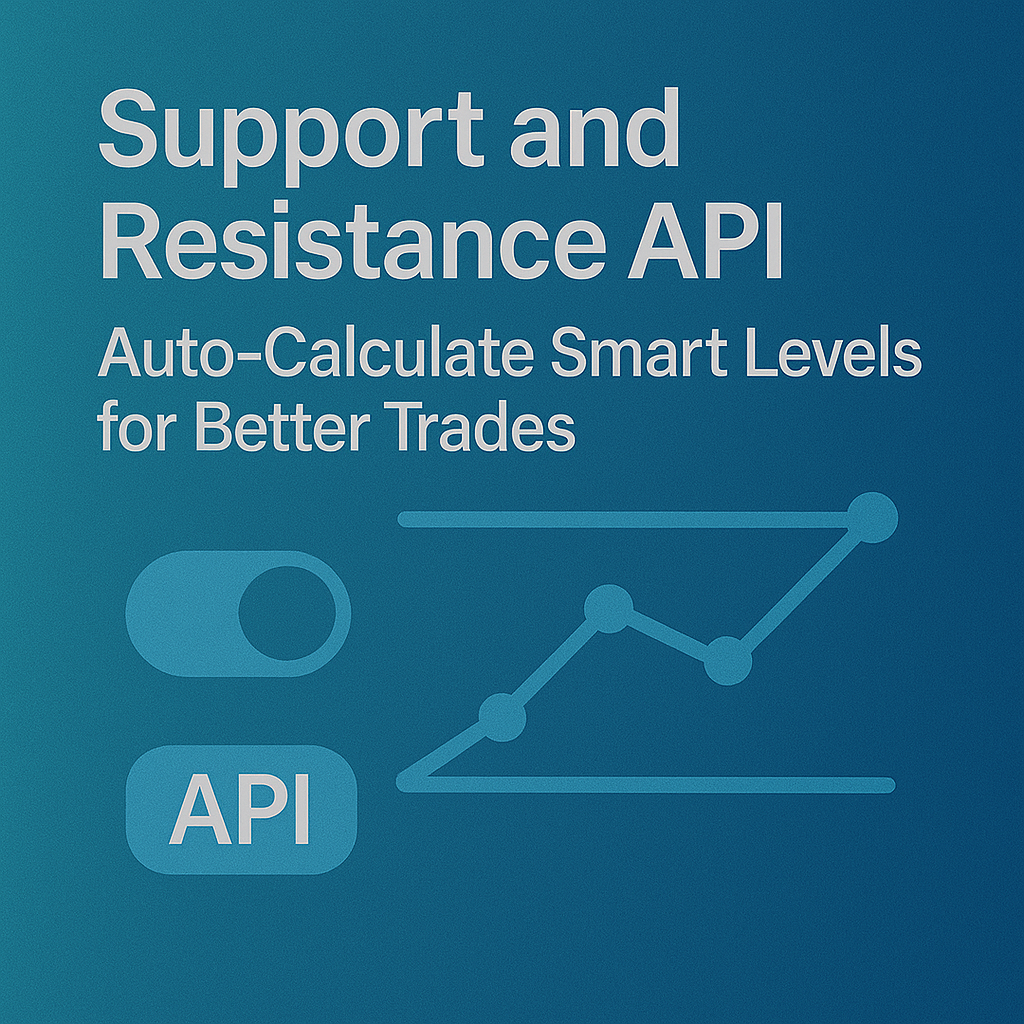Top Crypto Trading Platforms in 2025







%201.svg)
%201.svg)
Big news: We’re cranking up the heat on AI-driven crypto analytics with the launch of the Token Metrics API and our official SDK (Software Development Kit). This isn’t just an upgrade – it's a quantum leap, giving traders, hedge funds, developers, and institutions direct access to cutting-edge market intelligence, trading signals, and predictive analytics.
Crypto markets move fast, and having real-time, AI-powered insights can be the difference between catching the next big trend or getting left behind. Until now, traders and quants have been wrestling with scattered data, delayed reporting, and a lack of truly predictive analytics. Not anymore.
The Token Metrics API delivers 32+ high-performance endpoints packed with powerful AI-driven insights right into your lap, including:
Getting started with the Token Metrics API is simple:
At Token Metrics, we believe data should be decentralized, predictive, and actionable.
The Token Metrics API & SDK bring next-gen AI-powered crypto intelligence to anyone looking to trade smarter, build better, and stay ahead of the curve. With our official SDK, developers can plug these insights into their own trading bots, dashboards, and research tools – no need to reinvent the wheel.
%201.svg)
%201.svg)
The biggest gains in crypto rarely come from the majors. They come from Moonshots—fast-moving tokens with breakout potential. The Moonshots API surfaces these candidates programmatically so you can rank, alert, and act inside your product. In this guide, you’ll call /v2/moonshots, display a high-signal list with TM Grade and Bullish tags, and wire it into bots, dashboards, or screeners in minutes. Start by grabbing your key at Get API Key, then Run Hello-TM and Clone a Template to ship fast.
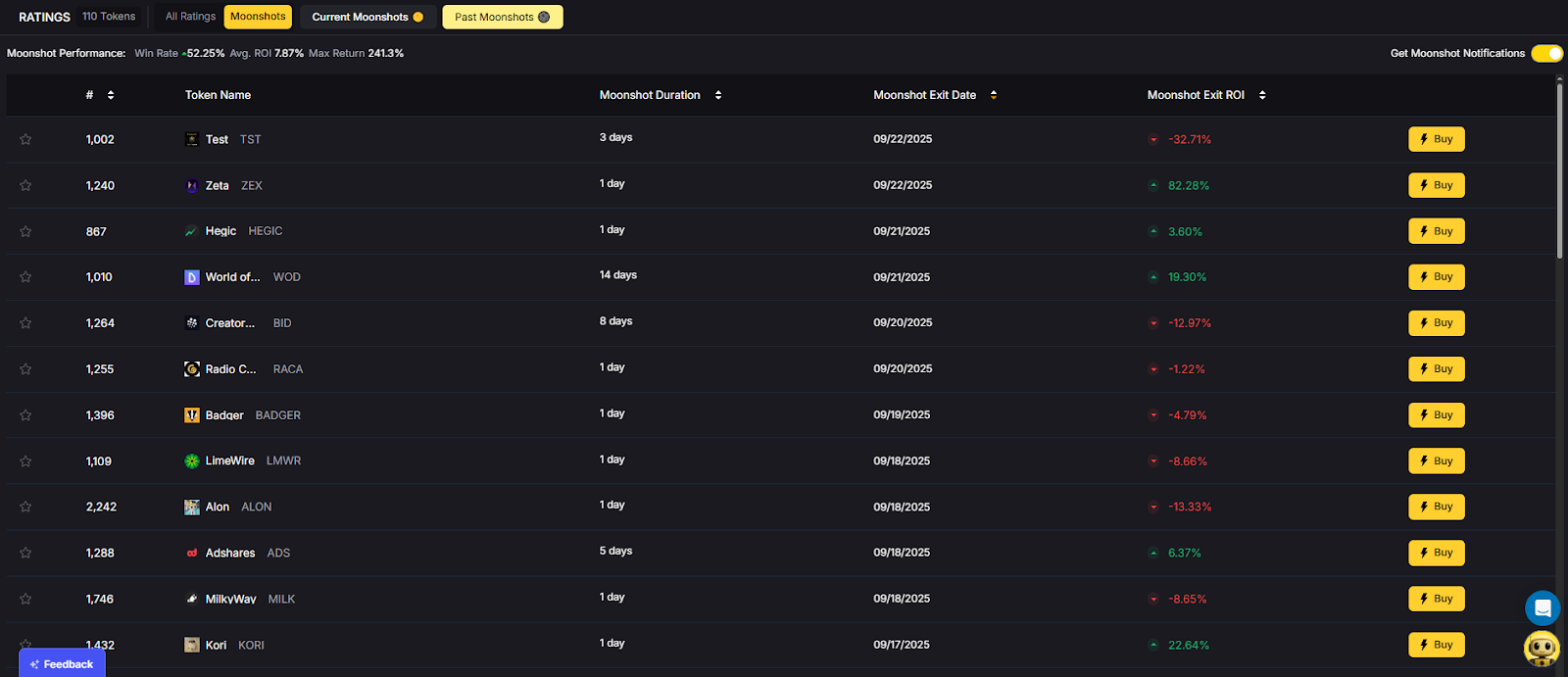
Discovery that converts. Users want more than price tickers—they want a curated, explainable list of high-potential tokens. The moonshots API encapsulates multiple signals into a short list designed for exploration, alerts, and watchlists you can monetize.
Built for builders. The endpoint returns a consistent schema with grade, signal, and context so you can immediately sort, badge, and trigger workflows. With predictable latency and clear filters, you can scale to dashboards, mobile apps, and headless bots without reinventing the discovery pipeline.
The Moonshots API cURL request is right there in the top right of the API Reference. Grab it and start tapping into the potential!
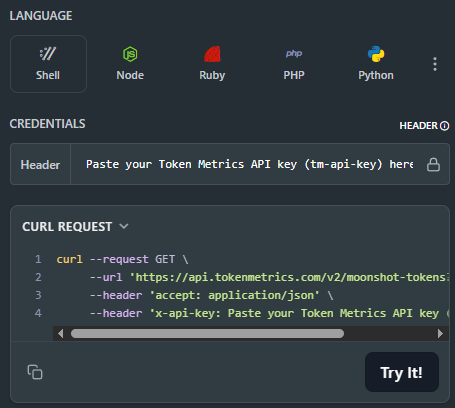
👉 Keep momentum: Get API Key • Run Hello-TM • Clone a Template
Fork a screener or alerting template, plug your key, and deploy. Validate your environment with Hello-TM. When you scale users or need higher limits, compare API plans.
The Moonshots endpoint aggregates a set of evidence—often combining TM Grade, signal state, and momentum/volume context—into a shortlist of breakout candidates. Each row includes a symbol, grade, signal, and timestamp, plus optional reason tags for transparency.
For UX, a common pattern is: headline list → token detail where you render TM Grade (quality), Trading Signals (timing), Support/Resistance (risk placement), Quantmetrics (risk-adjusted performance), and Price Prediction scenarios. This lets users understand why a token was flagged and how to act with risk controls.
Polling vs webhooks. Dashboards typically poll with short-TTL caching. Alerting flows use scheduled jobs or webhooks (where available) to smooth traffic and avoid duplicates. Always make notifications idempotent.
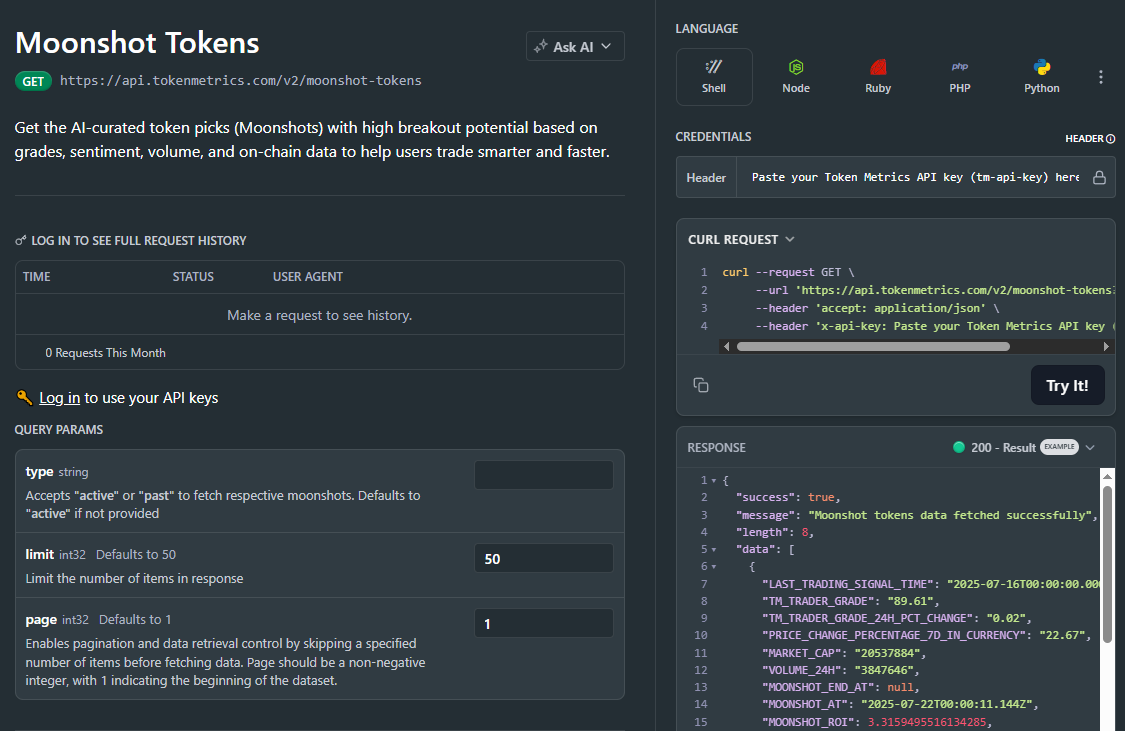
1) What does the Moonshots API return?
A list of breakout candidates with fields such as symbol, tm_grade, signal (often Bullish/Bearish), optional reason tags, and updated_at. Use it to drive discover tabs, alerts, and watchlists.
2) How fresh is the list? What about latency/SLOs?
The endpoint targets predictable latency and timely updates for dashboards and alerts. Use short-TTL caching and queued jobs/webhooks to avoid bursty polling.
3) How do I use Moonshots in a trading workflow?
Common stack: Moonshots for discovery, Trading Signals for timing, Support/Resistance for SL/TP, Quantmetrics for sizing, and Price Prediction for scenario context. Always backtest and paper-trade first.
4) I saw results like “+241%” and a “7.5% average return.” Are these guaranteed?
No. Any historical results are illustrative and not guarantees of future performance. Markets are risky; use risk management and testing.
5) Can I filter the Moonshots list?
Yes—pass parameters like min_grade, signal, and limit (as supported) to tailor to your audience and keep pages fast.
6) Do you provide SDKs or examples?
REST works with JavaScript and Python snippets above. Docs include quickstarts, Postman collections, and templates—start with Run Hello-TM.
7) Pricing, limits, and enterprise SLAs?
Begin free and scale up. See API plans for rate limits and enterprise options.
%201.svg)
%201.svg)
Most traders still draw lines by hand in TradingView. The support and resistance API from Token Metrics auto-calculates clean support and resistance levels from one request, so your dashboard, bot, or alerts can react instantly. In minutes, you’ll call /v2/resistance-support, render actionable levels for any token, and wire them into stops, targets, or notifications. Start by grabbing your key on Get API Key, then Run Hello-TM and Clone a Template to ship a production-ready feature fast.
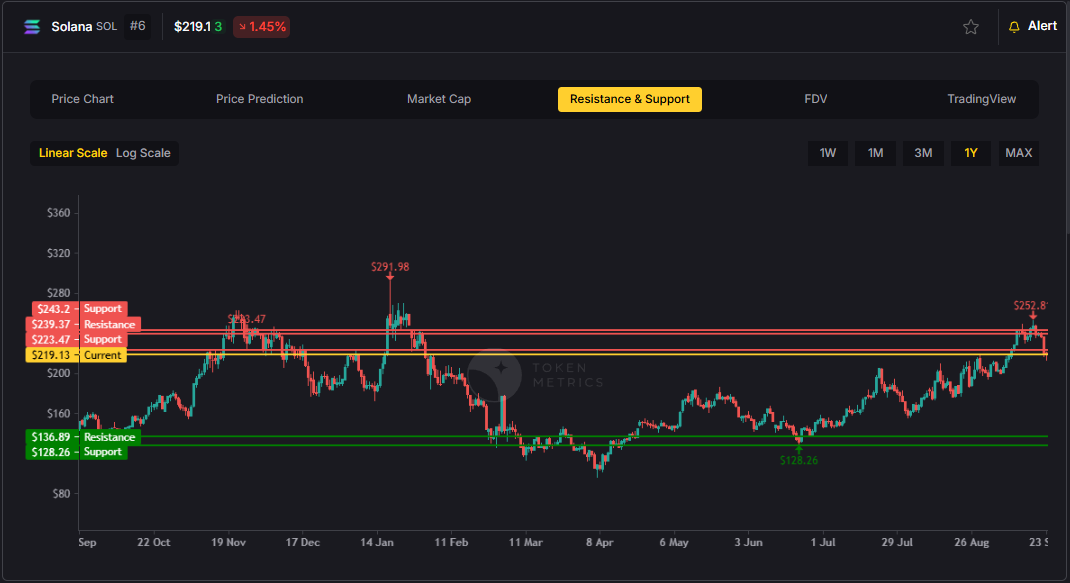
Precision beats guesswork. Hand-drawn lines are subjective and slow. The support and resistance API standardizes levels across assets and timeframes, enabling deterministic stops and take-profits your users (and bots) can trust.
Production-ready by design. A simple REST shape, predictable latency, and clear semantics let you add levels to token pages, automate SL/TP alerts, and build rule-based execution with minimal glue code.
Need the Support and Resistance data? The cURL request for it is in the top right of the API Reference for quick access.
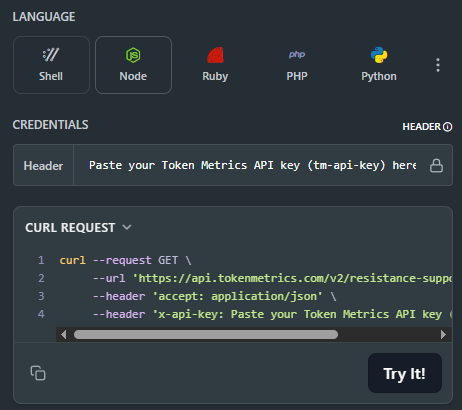
👉 Keep momentum: Get API Key • Run Hello-TM • Clone a Template
Kick off with our quickstarts—fork a bot or dashboard template, plug your key, and deploy. Confirm your environment by Running Hello-TM. When you’re scaling or need webhooks/limits, review API plans.
The Support/Resistance endpoint analyzes recent price structure to produce discrete levels above and below current price, along with strength indicators you can use for priority and styling. Query /v2/resistance-support?symbol=<ASSET>&timeframe=<HORIZON> to receive arrays of level objects and timestamps.
Polling vs webhooks. For dashboards, short-TTL caching and batched fetches keep pages snappy. For bots and alerts, use queued jobs or webhooks (where applicable) to avoid noisy, bursty polling—especially around market opens and major events.
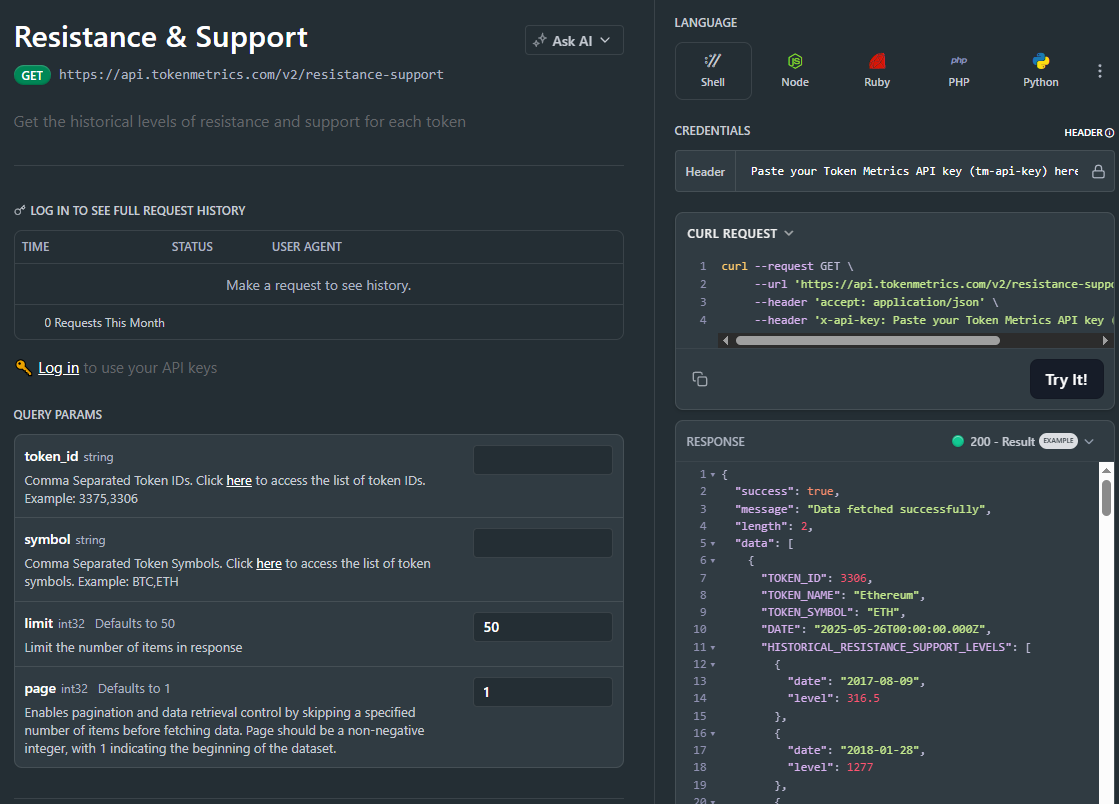
1) What does the Support & Resistance API return?
A JSON payload with arrays of support and resistance levels for a symbol (and optional timeframe), each with a price and strength indicator, plus an update timestamp.
2) How timely are the levels? What are the latency/SLOs?
The endpoint targets predictable latency suitable for dashboards and alerts. Use short-TTL caching for UIs, and queued jobs or webhooks for alerting to smooth traffic.
3) How do I trigger alerts or trades from levels?
Common patterns: alert when price is within X% of a level, touches a level, or breaks beyond with confirmation. Always make downstream actions idempotent and respect rate limits.
4) Can I combine levels with other endpoints?
Yes—pair with /v2/trading-signals for timing, /v2/tm-grade for quality context, and /v2/quantmetrics for risk sizing. This yields a complete decide-plan-execute loop.
5) Which timeframe should I use?
Intraday bots prefer shorter horizons; swing/position dashboards use daily or higher-timeframe levels. Offer a timeframe toggle and cache results per setting.
6) Do you provide SDKs or examples?
Use the REST snippets above (JS/Python). The docs include quickstarts, Postman collections, and templates—start with Run Hello-TM.
7) Pricing, limits, and enterprise SLAs?
Begin free and scale as you grow. See API plans for rate limits and enterprise SLA options.
%201.svg)
%201.svg)
Most traders see price—quants see probabilities. The Quantmetrics API turns raw performance into risk-adjusted stats like Sharpe, Sortino, volatility, drawdown, and CAGR so you can compare tokens objectively and build smarter bots and dashboards. In minutes, you’ll query /v2/quantmetrics, render a clear performance snapshot, and ship a feature that customers trust. Start by grabbing your key at Get API Key, Run Hello-TM to verify your first call, then Clone a Template to go live fast.
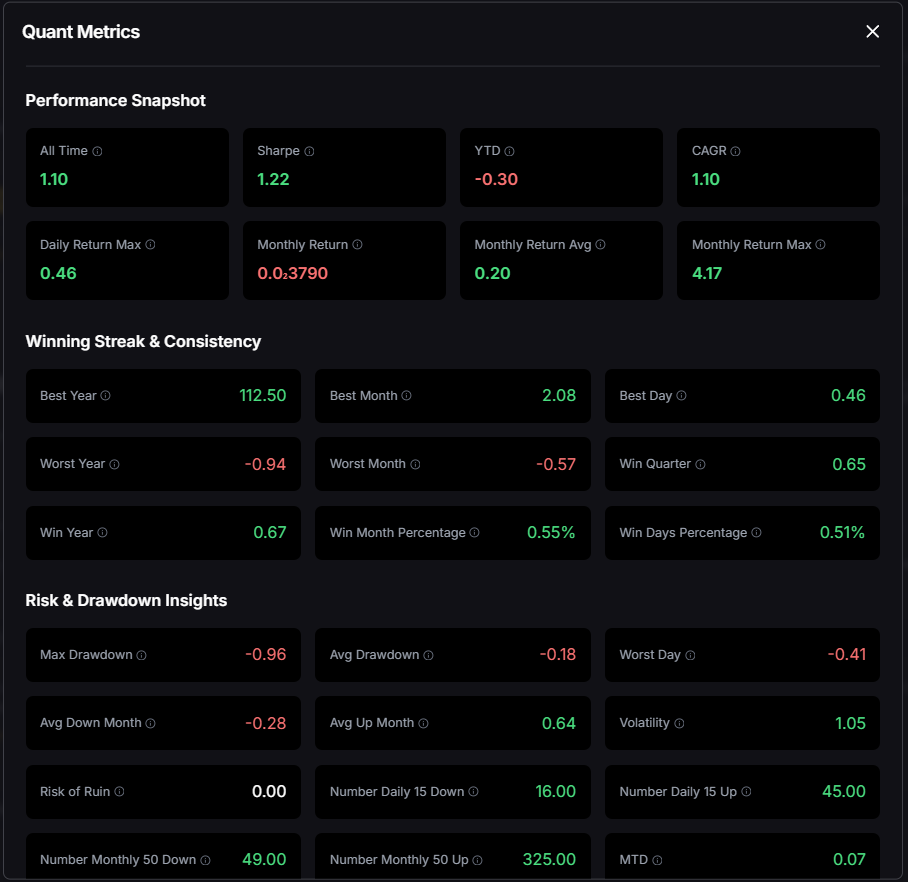
Risk-adjusted truth beats hype. Price alone hides tail risk and whipsaws. Quantmetrics compresses edge, risk, and consistency into metrics that travel across assets and timeframes—so you can rank universes, size positions, and communicate performance like a pro.
Built for dev speed. A clean REST schema, predictable latency, and easy auth mean you can plug Sharpe/Sortino into bots, dashboards, and screeners without maintaining your own analytics pipeline. Pair with caching and batching to serve fast pages at scale.
The Quant Metrics cURL request is located in the top right of the API Reference, allowing you to easily integrate it with your application.
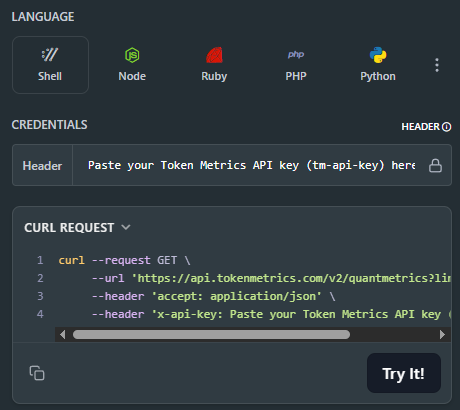
👉 Keep momentum: Get API Key • Run Hello-TM • Clone a Template
Kick off from quickstarts in the docs—fork a dashboard or screener template, plug your key, and deploy in minutes. Validate your environment with Run Hello-TM; when you need more throughput or webhooks, compare API plans.
Quantmetrics computes risk-adjusted performance over a chosen lookback (e.g., 30d, 90d, 1y). You’ll receive a JSON snapshot with core statistics:
Call /v2/quantmetrics?symbol=<ASSET>&window=<LOOKBACK> to fetch the current snapshot. For dashboards spanning many tokens, batch symbols and apply short-TTL caching. If you generate alerts (e.g., “Sharpe crossed 1.5”), run a scheduled job and queue notifications to avoid bursty polling.
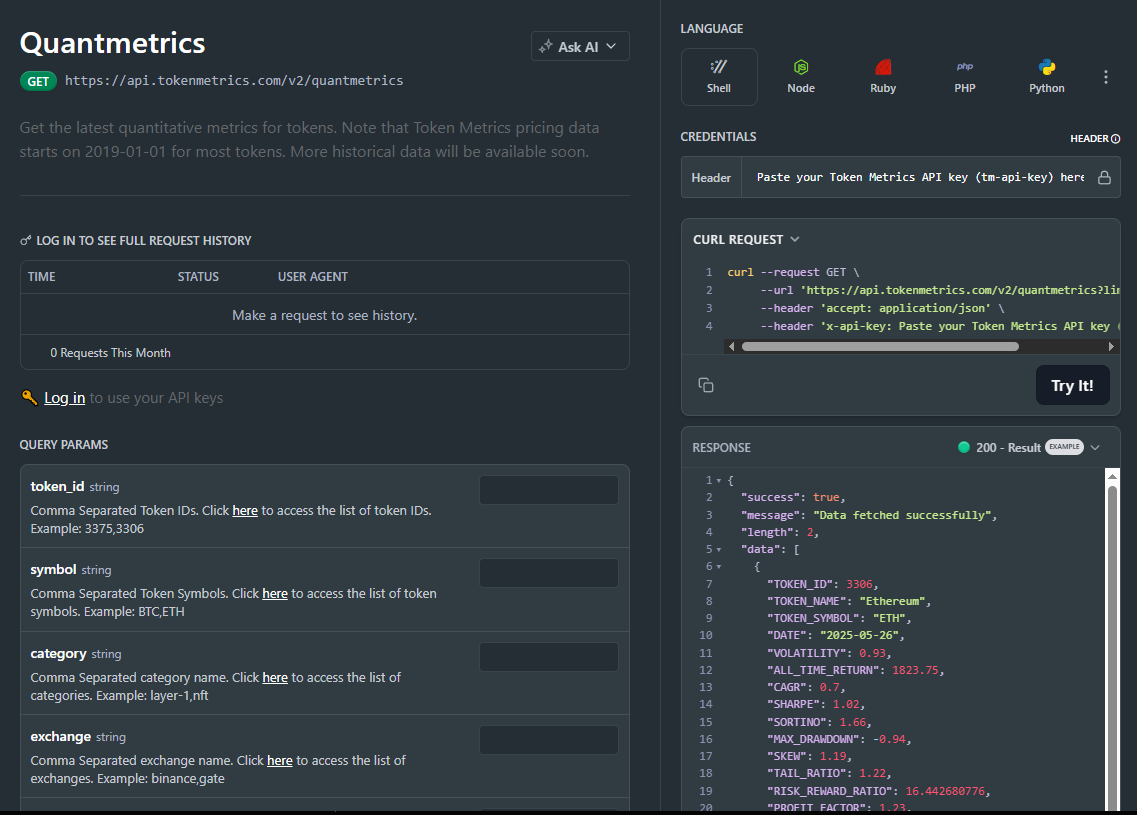
1) What does the Quantmetrics API return?
A JSON snapshot of risk-adjusted metrics (e.g., Sharpe, Sortino, volatility, max drawdown, CAGR) for a symbol and lookback window—ideal for ranking, sizing, and dashboards.
2) How fresh are the stats? What about latency/SLOs?
Responses are engineered for predictable latency. For heavy UI usage, add short-TTL caching and batch requests; for alerts, use scheduled jobs or webhooks where available.
3) Can I use Quantmetrics to size positions in a live bot?
Yes—many quants size inversely to volatility or require Sharpe ≥ X to trade. Always backtest and paper-trade before going live; past results are illustrative, not guarantees.
4) Which lookback window should I choose?
Short windows (30–90d) adapt faster but are noisier; longer windows (6–12m) are steadier but slower to react. Offer users a toggle and cache each window.
5) Do you provide SDKs or examples?
REST is straightforward (JS/Python above). Docs include quickstarts, Postman collections, and templates—start with Run Hello-TM.
6) Polling vs webhooks for quant alerts?
Dashboards usually use cached polling. For threshold alerts (e.g., Sharpe crosses 1.0), run scheduled jobs and queue notifications to keep usage smooth and idempotent.
7) Pricing, limits, and enterprise SLAs?
Begin free and scale up. See API plans for rate limits and enterprise SLA options.

%201.svg)
%201.svg)
In 2025, cryptocurrency trading is more accessible than ever, with hundreds of exchanges competing for your attention. But choosing the right exchange can make the difference between a smooth, profitable trading experience and one full of unnecessary risks, high fees, or limited features.
If you’re asking “Which cryptocurrency exchange should I use?”, this guide will help you compare the top platforms and explain how Token Metrics — the leading AI‑powered crypto analysis, research, and trading platform — can help you trade smarter no matter which exchange you choose.
Before selecting an exchange, it’s important to understand your options:
1. Centralized Exchanges (CEXs):
2. Decentralized Exchanges (DEXs):
3. Hybrid Exchanges:
Pro Tip: Beginners usually start with a trusted CEX, then gradually explore DEXs for more control and advanced opportunities.
Here are some of the leading exchanges to consider:
When deciding which platform to use, consider:
Choosing an exchange is just the first step. To maximize profits, you need data‑driven insights, trend detection, and portfolio strategies — that’s where Token Metrics comes in.
No matter which exchange you choose, Token Metrics empowers you to trade smarter with AI‑powered crypto analysis, research, and trading tools.

Here’s how:
In short: Token Metrics isn’t an exchange — it’s your personal AI crypto research assistant.
Let’s say you trade on Binance:
This combination lets you trade like a pro without guesswork.
No matter which exchange you choose:
So, which cryptocurrency exchange should you use?
But remember — the exchange is only part of the equation.
To trade profitably in 2025, pair your chosen exchange with Token Metrics — the ultimate AI‑powered crypto research, analysis, and trading platform.
Whether you’re buying your first Bitcoin or trading advanced altcoins, Token Metrics helps you cut through noise, detect trends early, and make smarter, data‑driven decisions.

%201.svg)
%201.svg)
Cryptocurrency trading has grown from a niche activity into a global financial revolution, with billions traded daily across thousands of digital assets. In 2025, crypto trading isn’t just about buying Bitcoin—it’s a sophisticated market with opportunities in altcoins, AI tokens, DeFi protocols, and more.
But getting started can be overwhelming. If you’re asking, “How do I start trading cryptocurrency?”, this guide will walk you through everything—from setting up accounts to using AI‑powered tools like Token Metrics to trade smarter.

Before you trade, you need to understand what you’re trading.
Pro Tip: Use Token Metrics’ coin ratings to evaluate projects based on fundamentals, technicals, and on‑chain data.
To start trading, you’ll need an account on a crypto exchange.
Centralized Exchanges (CEXs):
Decentralized Exchanges (DEXs):
Pro Tip: Start with a reputable CEX, then gradually explore DEXs as you gain experience.
A wallet stores your crypto securely.

Rule of Thumb:
To trade, you’ll need to deposit money:
Pro Tip: Always use verified exchanges to avoid scams.
Crypto trading isn’t just buying and holding. Common strategies include:
Pro Tip: Start with spot trading before exploring advanced strategies.
Trading requires informed decisions, not guesses.
Types of Analysis:
Token Metrics simplifies this with AI‑powered coin ratings, narrative detection, and real‑time analytics.
Crypto is volatile. Start with a small allocation (1–5% of your portfolio) while you learn the ropes.
Golden Rule:
Never invest money you can’t afford to lose.
Risk management is critical for long‑term success.
Pro Tip: Token Metrics’ portfolio optimizer can help balance risk and return.
Don’t trade emotionally. Create a plan that includes:
AI‑powered tools like Token Metrics can automate alerts for your planned price levels.
The crypto market moves fast. Keep learning:
Trading doesn’t have to be guesswork. AI platforms like Token Metrics help by:
With AI, even beginners can trade like seasoned professionals.
Starting your crypto trading journey in 2025 is easier than ever — but success requires planning, discipline, and the right tools.
By choosing a reliable exchange, using secure wallets, starting small, and leveraging AI‑driven insights from Token Metrics, you can confidently navigate the crypto market and turn trading into a profitable venture.
In crypto, knowledge is power — and in 2025, AI‑powered knowledge is the ultimate advantage.

%201.svg)
%201.svg)
Cryptocurrency has always been volatile, but in 2025, the stakes are even higher. With billions flowing into AI‑driven tokens, real‑world asset (RWA) projects, DeFi protocols, and meme coins, the crypto market is more complex than ever.
While the potential for profits is enormous, so are the risks. Poor risk management can quickly turn promising portfolios into catastrophic losses. To succeed, you need structured strategies and AI‑powered insights from platforms like Token Metrics to help you make smarter, data‑driven decisions.
This guide explores the top strategies for managing crypto risk in 2025 — helping you stay profitable even in turbulent markets.
Don’t put all your crypto in one basket.
Diversification reduces your exposure to individual asset failures. In 2025, this means spreading across:
Pro Tip: Use Token Metrics’ portfolio optimization tool to create a diversified, AI‑recommended allocation aligned with your risk tolerance.
Position sizing determines how much of your portfolio is allocated to a single asset.
Key Rule: Never risk more than you’re willing to lose.
Crypto markets move fast — sometimes too fast for manual reactions.
Stop‑Loss Orders:
Take‑Profit Orders:
Why It Works: These orders enforce discipline, removing emotional decision‑making from the equation.

Stablecoins like USDC and USDT are essential for risk management.
Platforms like Token Metrics help track the optimal balance between stablecoins and risk assets for your portfolio.
Leverage amplifies both gains and losses.
AI‑powered insights from Token Metrics can help you assess volatility before taking leveraged positions.
DCA means investing a fixed amount regularly, regardless of price.
Pairing DCA with Token Metrics’ trend analysis ensures you’re accumulating assets with strong AI‑verified fundamentals.
Markets shift quickly. Rebalancing keeps your portfolio aligned with your goals.

Rebalance when:
Token Metrics’ portfolio tracker helps monitor your allocations and signals when adjustments are needed.
Narratives drive capital flows in crypto — AI tokens, DeFi 2.0, RWAs, and more are shaping 2025.
Why It Matters:
Token Metrics’ narrative detection tools help you spot these shifts early.
Even the best portfolio is useless if it’s hacked.

Crypto moves at lightning speed. Staying informed reduces surprises:


This portfolio balances security, growth, and liquidity.
Managing risk in crypto isn’t about avoiding volatility — it’s about embracing it intelligently.
By combining diversification, automated trading tools, hedging, and AI‑driven insights from Token Metrics, you can protect your capital and position yourself for consistent growth in 2025.
In crypto, survival is success — and with the right risk management strategies, you can turn survival into long‑term profitability.

%201.svg)
%201.svg)
Zero Knowledge Proofs (ZKPs) represent a groundbreaking cryptographic concept that enables one party to prove knowledge of specific information to another party without revealing the information itself. This technology is rapidly gaining traction within blockchain ecosystems and privacy-focused applications, offering novel approaches to verification and security without compromising sensitive data.
At its core, a Zero Knowledge Proof is a method by which a prover demonstrates to a verifier that a given statement is true, without revealing any additional information beyond the validity of the statement. Introduced in the 1980s, ZKPs rely on complex mathematical algorithms to ensure that knowledge can be proven without disclosure, preserving confidentiality.
The three essential properties that characterize zero knowledge proofs are:
There are several approaches to implementing ZKPs, each with its trade-offs and applications. Two of the most significant forms include zk-SNARKs and zk-STARKs.
Zero Knowledge Proofs have considerable implications for enhancing privacy and scalability in decentralized systems. Key applications include:
Despite their potential, Zero Knowledge Proofs face notable challenges that require careful consideration in practical deployment:
Advancements in Artificial Intelligence (AI) have begun to complement cryptographic research, including the exploration and utilization of Zero Knowledge Proofs. AI-driven analytical tools can assist researchers and developers by:
Platforms such as Token Metrics leverage AI-driven research to analyze emerging cryptographic technologies, including zero knowledge protocols, offering quantitative insights into technological developments and ecosystem dynamics.
When evaluating projects that incorporate zero knowledge proofs, consider the following research aspects to obtain an objective and thorough understanding:
Zero Knowledge Proofs are poised to become foundational in advancing privacy and scalability in decentralized systems. Future research continues to focus on:
Continued innovation in this domain is supported by cross-disciplinary collaborations, including cryptography, computer science, and AI research.
Zero Knowledge Proofs offer a powerful paradigm shift in cryptography, enabling privacy-preserving verification without information disclosure. Their adoption within blockchain and related fields supports the creation of secure, efficient, and private systems. Utilizing AI-powered platforms like Token Metrics can assist in analyzing and understanding the evolving landscape of zero knowledge proof technologies.
This article is for educational and informational purposes only. It does not constitute financial advice, investment recommendations, or endorsements. Readers should conduct their own research and consult professionals before making decisions related to cryptographic technologies or blockchain projects.

%201.svg)
%201.svg)
As the blockchain landscape evolves, the term "Web3 wallets" has become fundamental in discussions around decentralized finance and digital asset management. Web3 wallets act as a gateway for users to interact with decentralized applications (dApps), access blockchain networks, and securely manage their digital assets without reliance on centralized intermediaries.
This article explores the concept of Web3 wallets, their types, core features, and the security considerations essential for users. It also highlights how analytical platforms like Token Metrics can aid in understanding the complexities surrounding these wallets and blockchain technologies.
Web3 wallets are software or hardware tools that enable users to store, send, receive, and interact with cryptocurrencies and tokens on blockchain networks. Unlike traditional digital wallets, Web3 wallets are designed primarily to facilitate decentralized interactions beyond simple transactions, such as signing smart contracts and accessing dApps.
They come in two main forms:
Understanding the various types of Web3 wallets helps users select options that fit their security posture and use cases.
Web3 wallets provide a suite of functionalities tailored to decentralized ecosystems:
Security remains paramount for Web3 wallet users due to the irreversible nature of blockchain transactions and increasing cyber threats:
The complexity of blockchain ecosystems has led to the emergence of AI-driven analytical platforms that assist users and researchers in understanding market trends, token metrics, and network behaviors. Token Metrics is an example of such a tool, providing data-backed ratings and insights that can complement wallet usage by offering research capabilities on tokens and market conditions.
These platforms can support educational efforts by:
Choosing the right Web3 wallet is a process that balances ease of use, security, and compatibility needs:
Additionally, engaging with AI-driven platforms like Token Metrics can provide analytical depth during the research phase and support ongoing management of crypto assets.
Web3 wallets represent a critical component of the decentralized internet, empowering users to control their digital assets and participate in blockchain ecosystems securely and effectively. By understanding wallet types, functionalities, and security measures, users can navigate this complex space with greater confidence.
Tools like Token Metrics serve as valuable resources for educational and analytical purposes, enabling deeper insight into token fundamentals and network dynamics.
Disclaimer: This article is intended for educational purposes only and does not constitute financial or investment advice. Readers should conduct their own research and consider their risk tolerance before engaging with any cryptocurrency or blockchain technology.

%201.svg)
%201.svg)
The term altcoins broadly refers to all cryptocurrencies that exist as alternatives to Bitcoin, the pioneering digital currency. Since Bitcoin’s inception in 2009, thousands of alternative crypto coins have emerged with a variety of designs, purposes, and technologies. Understanding what altcoins are and how they differ from Bitcoin and one another is vital for anyone interested in the cryptocurrency ecosystem.
Altcoins are digital assets that operate on blockchain technology but distinguish themselves from Bitcoin in technical structure or intended utility. Technically, the name is a contraction of “alternative coins.” Altcoins encompass a wide range of projects, including but not limited to:
Many altcoins distinguish themselves by innovating on blockchain design, consensus mechanisms, scalability, and privacy. For instance, some use Proof of Stake instead of Bitcoin’s Proof of Work to reduce energy consumption. Others implement advanced cryptographic techniques to enhance transaction confidentiality. These technical differences contribute to the diverse use cases altcoins pursue and can affect their adoption and network effects within various communities.
Evaluating altcoins requires a multifaceted approach that considers technology fundamentals, development activity, community support, and use cases. Research techniques often include:
Advanced AI-driven research tools like Token Metrics synthesize vast amounts of data and market signals to provide quantitative ratings and analysis, aiding in a more informed understanding of altcoin projects.
While Bitcoin is primarily conceived as a decentralized digital currency and store of value, altcoins often aim to address specific limitations or explore novel functionalities. Differences can include:
Understanding these distinctions informs discussions around the complementary roles altcoins play alongside Bitcoin in the broader crypto ecosystem.
Due to the large number and variety of altcoins, the space involves considerable complexity and risk. Important considerations include:
Using analytics platforms like Token Metrics can provide data-driven insights into these factors by compiling technical, fundamental, and sentiment indicators.
AI-powered platforms enable systematic, scalable analysis of altcoins through machine learning models harnessing blockchain data, news sentiment, and market indicators. To incorporate these tools effectively:
Altcoins represent a diverse and rapidly evolving segment of the cryptocurrency landscape, designed to explore new functionalities and solve various challenges beyond Bitcoin’s scope. They encompass broad categories, from payments and smart contract platforms to privacy and stablecoins. Due to the complexity and number of projects, rigorous, data-informed research approaches are essential to understand their technology, use cases, and network health.
AI-driven research tools such as Token Metrics offer valuable support in this endeavor by aggregating multiple data streams into comprehensive analysis, helping stakeholders objectively compare altcoins on various factors.
This blog post is for educational and informational purposes only and does not constitute financial, investment, or trading advice. Readers should conduct their own independent research before engaging with cryptocurrencies.

%201.svg)
%201.svg)
In 2025, cryptocurrency trading has evolved far beyond manual chart analysis and intuition. Artificial Intelligence (AI) is now at the forefront of trading strategies, enabling investors to process massive amounts of data, predict market movements, and make faster, smarter decisions.
AI trading tools have become indispensable for retail and institutional traders alike, offering insights that were once only available to hedge funds with large research teams. This article explores the best AI tools for crypto trading in 2025, with a special focus on how platforms like Token Metrics give traders a competitive edge.
AI crypto trading tools use machine learning algorithms, predictive analytics, and natural language processing to analyze market data and provide actionable insights.
These platforms help traders:
In short, AI tools turn complex crypto data into clear, actionable decisions.

Best For: Portfolio optimization, coin ratings, and narrative detection
Token Metrics is one of the most advanced AI‑powered crypto platforms in 2025. Designed for both traders and long‑term investors, it uses over 80 data points per token to generate AI‑driven ratings, predictions, and portfolio recommendations.
Key Features:
Why It’s Great:
Token Metrics is more than a tool — it’s a full trading intelligence platform. It helps users discover hidden gems, fine‑tune strategies, and stay ahead of shifting market conditions.

Best For: Automated crypto trading bots
CryptoHopper allows traders to automate their trading strategies using AI‑powered bots. It connects to major exchanges and executes trades based on predefined conditions, reducing emotional trading.
Key Features:
Why It’s Great:
For traders who want hands‑off execution, CryptoHopper provides robust automation paired with AI insights.

Best For: Multi‑exchange trading and smart portfolio management
3Commas combines AI‑driven analytics with smart trading tools, allowing users to execute trades across multiple exchanges.
Key Features:
Why It’s Great:
3Commas is ideal for active traders managing multiple accounts across different platforms.

Best For: Grid and arbitrage trading
Pionex specializes in AI‑powered grid trading, which profits from market volatility.
Key Features:
Why It’s Great:
Pionex helps beginner and intermediate traders profit from sideways markets using low‑maintenance AI bots.
Best For: Crowdsourced AI predictions
Numerai Signals collects machine learning models from data scientists worldwide to generate highly predictive trading insights.
Key Features:
Why It’s Great:
Numerai offers unique crowdsourced intelligence, making it an attractive tool for data‑driven traders.
When selecting a platform, consider:
The best approach in 2025 isn’t using just one tool — it’s combining multiple platforms:
This hybrid approach creates a comprehensive AI‑driven trading strategy.
While AI can enhance trading, it isn’t foolproof:
Using Token Metrics’ AI analytics helps mitigate these risks by providing transparent, multi‑factor coin ratings.
AI is transforming how crypto trading works in 2025. From narrative detection to automated execution, these tools give traders the ability to make smarter, faster, and more profitable decisions.
Token Metrics leads the way, offering AI‑powered coin ratings, trend detection, and portfolio optimization — making it the ideal platform for traders and investors aiming to stay ahead in a volatile market.
In crypto, information is power — and with the right AI tools, you can turn that information into consistent profits.

%201.svg)
%201.svg)
The cryptocurrency market in 2025 has matured into a multi‑trillion‑dollar ecosystem, offering opportunities across Bitcoin, altcoins, DeFi platforms, AI‑powered tokens, and real‑world asset tokenization projects. However, with opportunity comes complexity — and building a profitable portfolio requires more than just guessing which coins might pump next.
Success now depends on strategic allocation, data‑driven decision‑making, and leveraging advanced tools like Token Metrics to analyze market trends and optimize performance. This guide will walk you through how to construct and maintain a profitable crypto portfolio in 2025.
Before choosing any assets, decide on your objectives:

Having clear goals will guide how much risk to take and which assets to prioritize.
Diversification remains the cornerstone of a strong crypto portfolio. In 2025, this means spreading across:
1. Large‑Cap Coins (40–50%):
Stable, highly liquid assets like BTC and ETH provide security and long‑term growth.
2. Mid‑Cap Coins (25–30%):
Projects like Polygon (MATIC) or Arbitrum (ARB) with strong fundamentals and adoption potential.
3. Small‑Cap Gems (10–20%):
High‑risk projects like AI tokens (TMAI) or early‑stage DeFi protocols with explosive upside.
4. Stablecoins (5–10%):
USDC or USDT for liquidity management, making it easier to buy dips or take profits quickly.
In crypto, narratives drive capital flows. Spotting the right trends early can turn modest investments into significant gains.
Hot narratives for 2025 include:

Pro Tip: Use Token Metrics’ narrative detection tools to spot these trends early.
Building a profitable portfolio requires cutting‑edge analytics, and AI is a game‑changer in 2025.
Token Metrics provides:

These insights give you a data‑driven edge in a volatile market.
Managing risk is as important as chasing gains. Key practices include:
In addition to growth, aim for consistent income streams:

Token Metrics’ staking analytics help you find the best yields while minimizing risk.
Crypto markets change fast. What worked six months ago might not work today.
Regularly monitor:
By actively managing your portfolio, you’ll avoid being caught off guard by market shifts.
Long‑Term Growth Portfolio:

This allocation balances security, growth, and flexibility.
A profitable crypto portfolio in 2025 combines diversification, narrative‑driven plays, and AI‑powered insights.
By leveraging Token Metrics for analytics, ratings, and portfolio optimization, you can minimize risk, maximize returns, and stay ahead of market trends.
In crypto, knowledge and data are power — and in 2025, those who combine both will lead the next wave of wealth creation.
.png)
%201.svg)
%201.svg)
The crypto ecosystem refers to the interconnected network of technologies, platforms, and participants that make up the cryptocurrency space. It’s more than just Bitcoin and altcoins — it includes blockchains, decentralized applications, exchanges, wallets, staking systems, analytics platforms, and communities.
In 2025, the crypto ecosystem has matured significantly, with billions in institutional capital, AI‑driven analytics, and real‑world applications shaping its growth. Understanding this ecosystem is crucial for navigating opportunities and risks in the digital asset space.
Each component interacts to create a self‑sustaining digital economy:
This interconnectedness is why understanding the ecosystem holistically is vital for long‑term success in crypto.
Artificial intelligence is transforming how investors engage with crypto. Platforms like Token Metrics offer:

In 2025, AI is no longer optional — it’s an essential tool for surviving the complexity of the crypto market.

For investors, the ecosystem offers multiple revenue streams:
Despite its growth, the crypto ecosystem still carries risks:
Platforms like Token Metrics mitigate these risks by providing real‑time insights, ratings, and AI‑powered alerts.

By 2025, the crypto ecosystem has shifted from speculation to utility‑driven growth. With AI integration, institutional adoption, and real‑world use cases, crypto is evolving into a mainstream part of global finance.
Projects like Token Metrics are leading the charge by making advanced analytics accessible to everyday investors, ensuring they can thrive in this rapidly evolving environment.
The crypto ecosystem in 2025 is a dynamic, interconnected web of technologies, platforms, and communities. To succeed, investors must understand its components and use the right tools to navigate it.
By combining education, diversification, and AI‑powered analytics from Token Metrics, you can confidently explore the ecosystem, capitalize on emerging opportunities, and mitigate risks in this transformative space.


 Create Your Free Account
Create Your Free Account9450 SW Gemini Dr
PMB 59348
Beaverton, Oregon 97008-7105 US
.svg)




.png)
Token Metrics Media LLC is a regular publication of information, analysis, and commentary focused especially on blockchain technology and business, cryptocurrency, blockchain-based tokens, market trends, and trading strategies.
Token Metrics Media LLC does not provide individually tailored investment advice and does not take a subscriber’s or anyone’s personal circumstances into consideration when discussing investments; nor is Token Metrics Advisers LLC registered as an investment adviser or broker-dealer in any jurisdiction.
Information contained herein is not an offer or solicitation to buy, hold, or sell any security. The Token Metrics team has advised and invested in many blockchain companies. A complete list of their advisory roles and current holdings can be viewed here: https://tokenmetrics.com/disclosures.html/
Token Metrics Media LLC relies on information from various sources believed to be reliable, including clients and third parties, but cannot guarantee the accuracy and completeness of that information. Additionally, Token Metrics Media LLC does not provide tax advice, and investors are encouraged to consult with their personal tax advisors.
All investing involves risk, including the possible loss of money you invest, and past performance does not guarantee future performance. Ratings and price predictions are provided for informational and illustrative purposes, and may not reflect actual future performance.


